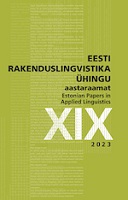How do Chinese L1 learners express Estonian static spatial relations?
How do Chinese L1 learners express Estonian static spatial relations?
Author(s): Agu BleiveSubject(s): Foreign languages learning, Sociolinguistics, Cognitive linguistics
Published by: Eesti Rakenduslingvistika Ühing (ERÜ)
Keywords: L2 spatial language; spatial relations; containment; support; location markers; language typology; Estonian; Chinese;
Summary/Abstract: The aim of this research was to find out how differences in Chinese and Estonian spatial language influence the way Chinese L1 speakers acquire the Estonian system of expressing static spatial relations. For this purpose, a picture description task was carried out by 22 native Chinese speakers. The main finding was that the Chinese L1 learners of Estonian did not use support through attachment relation (expressed by the postposition küljes) or support by the tip relation (expressed by the postposition otsas) almost at all. Instead, they used simple support relations (expressed by the adessive case or the postposition peal) similarly to their native language, which was in stark contrast with the native Estonian usage. Expressing containment relations did not pose such a problem to Chinese learners of Estonian. Another important finding was that Chinese learners of Estonian had a higher probability of using native-like logic in Estonian in choosing between support and containment relations while describing the pictures when they used case suffixes and a lower probability when they used adpositions.
Journal: Eesti Rakenduslingvistika Ühingu aastaraamat
- Issue Year: 2023
- Issue No: 19
- Page Range: 5-24
- Page Count: 20
- Language: English

